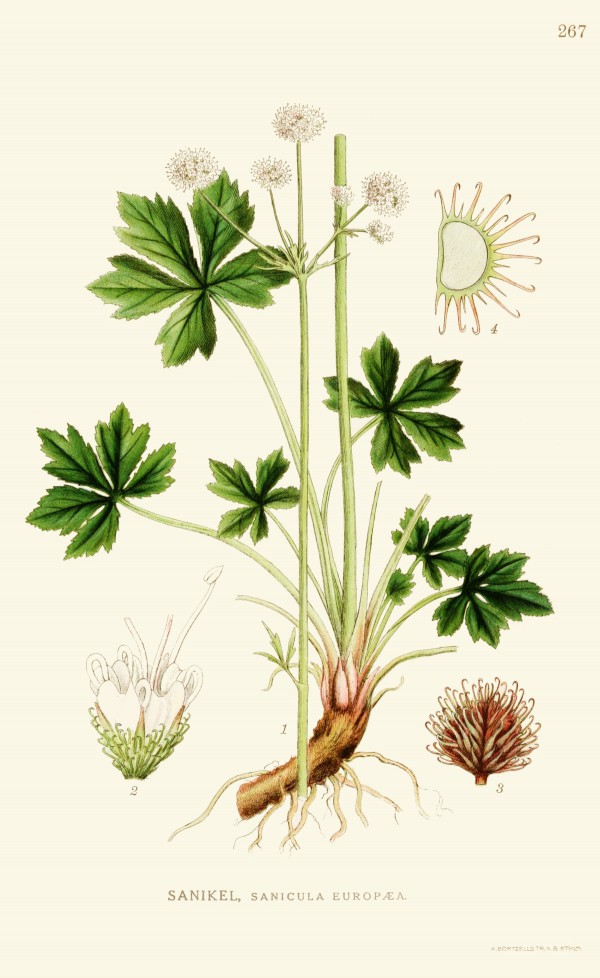Sanicula europaea L. - syn.Sanicula elata Ham. ex Don - Apiaceae - (European) sanicle, wood sanicle, Sanikel
Perennial herb, 20-40cm high, native to Eurasia; rootstock thick with fibrous roots; leaves long-petioled, palmately lobed, toothed; flowers white.
„Sanicle herb has been used mainly to treat catarrh of the upper respiratory tract and was a popular remedy for diarrhoea, stomach uppets, flatulence, excessive bleeding. As a gargle it was used in cases of sore throat, mouth infections and gingivitis. Leaves were once popular as a compress to treat wounds, bruises, burns, skin infections and haemorrhoids… Active Ingredients: Large amounts (more than 10%) of monodesmodic triterpene saponins (esters of saniculoside A-D), together with flavanoids (rutin, astragalin) various organic acids (chlorogenic acid 0.6%, rosmarinic acid 1.7%, ascorbic acid 0.1%) and mucilage“
[Medicinal Plants of the World. Ben-Erik Van Wyk and Michael Wink, Pretoria 2004, 288]
The herb contains saniculosides A-D, which are triterpene saponins with A1-barrigenol and R1-barrigenol as aglycones.
[Hagers Handbuch der Pharmazeutischen Praxis, Springer 2010]
[Glycosidstrukturen der Saponine von Sanicula europaea L. XXXIX: Zur Kenntnis der Inhaltsstoffe einiger Saniculoideae., Kühner, K., Voigt, G., Hiller, K., Rabe, H., Franke, P., Dube, G., Habisch, D., Pharmazie, Vol.40(8), 1985, 576-578]
„Extracts from the aerial parts of Sanicula europaea L. were investigated for their anti-HIV activity, and the 50% ethanolic extract was shown to exhibit the highest activity. A new triterpene saponin glycoside, 21β-(angeloyloxy)-3-O-[β-d-arabinopyranosyl(1→4)-β-d-glucopyranosyl(1→3)-β-d-glucuronopyranosyl propyl ester]-3β,15,16,22α,28β-pentahydroxy-Δ12-oleanene, saniculoside N, in addition to the known phenolic acids, rosmarinic acid, and caffeic acid were isolated as major components. Rosmarinic acid was established as the principal active substance.“
[Saniculoside N from Sanicula europaea L., Arda, N., Gören, N., Kuru, A., Pengsuparp, T., Pezzuto, J. M., Qiu, S.X., Cordell, G.A., Journal of natural products, Vol.60(11), 1997, 1170-1173]
„The antiviral activity of Sanicula europaea L. extracts against human parainfluenza virus type 2 (HPIV-2) was examined. The extract prepared from the leaves of the plant and a fraction separated from the crude extract with gel filtration chromatography were found to inhibit HPIV-2 replication without any toxic effect on Vero cells. The acidic fraction obtained from the crude extract of S. europaea leaves was found to be the most active fraction with plaque inhibition assay at non-cytotoxic concentrations. Unfortunately, antiviral activity was not detected in the molecules purified from the crude ethanol extract of Sanicula leaves.“
[Antiviral activity of Sanicula europaea L. extracts on multiplication of human parainfluenza virus type 2., Karagöz, A., Arda, N., Gören, N., Nagata, K., Kuru, A., Phytotherapy Research, Vol.13(5), 1999, 436-438]
„The chemical composition of essential oils obtained by hydrodistillation from leaves of Sanicula europaea L. originating from two different localities in Serbia and Montenegro was analyzed using GC and GC-MS. The oils were characterized by a high content of sesquiterpene hydrocarbons (59.5-63.8%). The major compounds were found to be β-selinene (40.4-44.2%), caryophyllene oxide (17.9-19.2%) and α-selinene (3.7-4.0%).“
[Essential oil composition of Sanicula europaea L., Pavlović, M., Kovačević, N., Tzakou, O., Couladis, M., Flavour and fragrance journal, Vol.21(4), 2006, 687-689]

Lindman, C.A.M., Bilder ur Nordens Flora, vol.2 t.267 (1922-1926)
http://plantillustrations.org/species.php?id_species=904843
Sanicula europaea
© Rolf Marschner (2007), http://botanische-spaziergaenge.at/viewtopic.php?f=120&t=2230